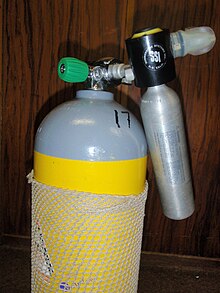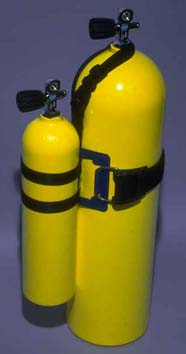


Filling a spare air bailout cylinder
| |
| Other names | Bailout cylinder, emergency gas supply |
|---|---|
| Uses | Emergency supply of breathing gas |
| Related items | Pony bottle |
Abailout bottle (BoB) or, more formally, bailout cylinder is a scuba cylinder carried by an underwater diver for use as an emergency supply of breathing gas in the event of a primary gas supply failure. A bailout cylinder may be carried by a scuba diver in addition to the primary scuba set, or by a surface supplied diver using either free-flow or demand systems.[1] The bailout gas is not intended for use during the dive except in an emergency, and would be considered a fully redundant breathing gas supply if used correctly. The term may refer to just the cylinder, or the bailout set or emergency gas supply (EGS), which is the cylinder with the gas delivery system attached. The bailout set or bailout system is the combination of the emergency gas cylinder with the gas delivery system to the diver, which includes a diving regulator with either a demand valve, a bailout block, or a bailout valve (BOV).
Insolo diving, a buddy bottle is a bailout cylinder carried as a substitute for an emergency gas supply from a diving buddy. A bailout cylinder for recreational scuba diving is often a small cylinder, known as a pony bottle, with a normal scuba regulator set, or a smaller cylinder with a combined first and second stage integrated with the cylinder valve, known as "Soare air", after a well known example of the type.
Rebreathers also have bailout systems, often including an open-circuit bailout bottle.[2][3]
The purpose of the bailout cylinder is to provide a fully redundant breathing gas supply for use in emergencies where a single gas mixture is appropriate. If more than one mixture is necessary for the ascent, redundant breathing gas is typically split between two or more cylinders carried by the diver, and in penetration diving where the diver is constrained to use the same route for exit as for entry, cylinders may be staged, which is a term meaning stowed along the route of the guideline, to be retrieved on the return.
For scuba, a "bailout bottle" or "self-contained ascent bottle" is a small diving cylinder meant to be used as an alternate air source to allow a controlled ascent with any required decompression, in place of a controlled emergency swimming ascent, which will not allow required decompression. A bailout cylinder is required equipment for a professional diver using scuba in some circumstances.[4]
Apony bottle is an example of a small bailout cylinder which has a standard diving regulator with first and second stages. There are also significantly smaller cylinders which have the first stage — and in the smallest models also the second stage — integrated into the cylinder valve itself.[5] A well-known example of this class of bailout bottle is the "Spare Air" set, which can supply a few breaths to allow the diver to ascend at a safe rate, but not enough to do a decompression stop. This type of bailout bottle is typically carried in a holster that is attached to the diver's harness.[6]
"Spare Air" bailout bottles, introduced in the 1980s, are very small cylinders with integral scuba regulators. Their disadvantage is that in many emergency situations they do not have sufficient capacity to get a diver back to the surface safely, and thus may cause divers carrying them to feel an unjustified sense of safety. Their advantage is that they are compact and easy to deploy, and that a small amount of air is better than none in an emergency.[6]
A review carried out by Scuba Diving magazine attempted to give a sense of from what depth bailout bottles of various capacities could get divers to the surface under maximum safe ascent rates, though the review cautioned that the reviewers were in controlled conditions and thus could not replicate the circumstances of an actual panicked diver. The review found that a 1.7-cubic-foot (0.24 L) bottle had sufficient air to get the reviewing diver from 45 feet (14 m) to the surface; a 3-cubic-foot (0.4 L) bottle from a depth of 70 feet (21 m); and a 6-cubic-foot (0.8 L) bottle from the maximum reviewed depth of 132 feet (40 m), which is the maximum depth recommended for recreational dives by some training agencies.[6] A bell diver must be able to return to the bell on the contents of the bailout cylinder, which will be influenced by the depth and umbilical length, and limited by the size of the bell entry lock manway.[7]


A bailout cylinder is defined by its function, and may be carried in any convenient way. The small "Spare Air" type is commonly carried in a pocket type holster which is strapped to the harness where it can easily be reached, usually somewhere on the front of a jacket style buoyancy compensator. Larger bailout cylinders may be strapped to the back cylinder, (see Pony bottle), or suspended from the harness D-rings along the side of the diver as a side-mount, or sling cylinder.[2][8] Surface-supplied divers usually carry the bailout set on a back-mount harness, as this leaves the arms unencumbered for work.[9]
In rebreather diving, bailout to open circuit is a procedure where the diver switches from breathing from the rebreather loop to open circuit. This is done when the loop is compromised for any reason, and is often done temporarily when there is some doubt that the gas in the loop is right for the depth. Bailout to open circuit may be a local switch-over at the bailout valve (BOV) to breathe gas directly from the diluent cylinder, or may be a switch to off-board gas, which is carried in an independent cylinder and is directly equivalent to open circuit bailout.[2] This may be done through an off-board supply connected to the BOV or through a regular fully independent bailout set carried for the purpose. Both options may be available on deep dives with long decompression obligations.[3] Occasionally rebreather divers will carry a bailout rebreather, when it is not practical to carry the required gas volume for open circuit bailout.

For commercial diving using surface-supplied breathing gas, the bailout cylinder is in many cases required by health and safety legislation[10] and approved codes of practice[11] as an obligatory component of the diving system. In this application the intention is that the bailout cylinder should hold sufficient breathing gas for the diver to be able to reach a place of safety where more breathing gas is available, such as the surface or a diving bell. To achieve this the cylinder must contain enough gas to allow decompression if that is included in the planned dive profile and there is no bell. Cylinder volumes are generally at least 7 litres, and may in some cases be as much as twin 12-litre sets.[citation needed] Bailout sets used by closed bell divers must provide enough gas to return to the bell, and must fit through the bottom airlock door.[7]
The emergency gas supply must support life at any depth where it is likely to be used. It will almost always be used for ascent or return to the bell, so a relatively oxygen-rich mixture will usually be advantageous. In closed bell diving an unusually high oxygen partial pressure of 2.8 bar as used in therapeutic decompression was recommended by Association of Offshore Diving Contractors (AODC) and endorsed by the Diving Medical Advisory Council (DMAC) in 1981, on the assumption that if the diver does not make it back into the bell on the bailout gas, or loses consciousness to acute oxygen toxicity, the chances of successful resuscitation will be better than in the case of hypoxia.[12] This strategy only holds when bailout is at constant pressure, the diver's airway is secured by a helmet, and there is a bellman to assist, as the risk of losing consciousness is relatively high.
Scuba divers cannot accept a high risk of oxygen toxicity convulsions and would usually consider an oxygen partial pressure of 1.6 bar to be the upper limit, though exposure at this pressure is likely to be of very short duration if an immediate ascent is started. It is common practice to use a non-optimised gas, as emergencies are not expected, and the same cylinder with the same gas may be carried on several dives, as long as the remaining quantity is sufficient.
The Diving Medical Advisory Council has more recently (2016) made a more conservative recommendation of an oxygen partial pressure for open circuit bailout for saturation divers of between 1.4 and 0.4 bar.[13]
Alternatives to a bailout cylinder include:
USNDM R7 was invoked but never defined (see the help page).|
| |||||||||||
|---|---|---|---|---|---|---|---|---|---|---|---|
| |||||||||||
| |||||||||||
| |||||||||||
| |||||||||||
| |||||||||||
| |||||||||||
| |||||||||||